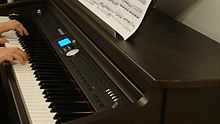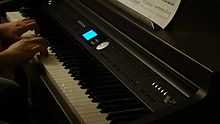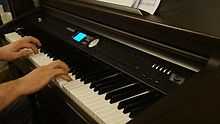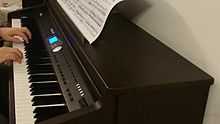Digital piano
A digital piano (not to be confused with electric piano and electronic piano) is a modern electronic musical instrument designed to serve primarily as an alternative to the traditional acoustic piano, both in the way it feels to play and in the sound produced. It is intended to provide an accurate simulation of an acoustic piano. Some digital pianos are also designed to look like an acoustic piano. While digital pianos may fall short of a real piano in feel and sound, they nevertheless have other advantages over acoustic pianos.
Features
The following is a list of features that typify the electric piano:
- Sound level/volume knobs, headphone inputs
- Low maintenance
- Many incorporate a MIDI implementation
- May have features to assist in learning and composition
- They often have a transposition feature
- They do not require the use of microphones
- Are often easily portable
- Depending on the individual features of each digital piano, they may include many more instrument sounds, including strings, guitars, organs, and more
- Typically feature weighted keys to mimic the feel of a traditional piano
Sounds




In most implementations, a digital piano produces a variety of piano timbres and usually other sounds as well. For example, a digital piano may have settings for a concert grand piano, an upright piano, a tack piano, and various electric pianos such as the Fender Rhodes and Wurlitzer. Some digital pianos incorporate other basic "synthesizer" sounds such as string ensemble, for example, and offer settings to combine them with piano.
In general, the sounds produced by a digital piano are based on sampling, by which real piano sound samples are stored in ROM. The samples stored in digital pianos are usually of very high quality and made using world class pianos, expensive microphones, and high-quality preamps in a professional recording studio.[1] ROM may include multiple samples for the same keystroke, attempting to reproduce diversity observed on the real piano, but the number of these recorded alternatives is limited.
Sample-based digital pianos do have limitations on the faithfulness with which they reproduce the sound of an acoustic piano. These might include the lack of implementation of harmonic tones that result when certain combinations of notes are sounded, limited polyphony, and a lack of natural reverberation when the instrument is played percussively. They often lack the incidental acoustic noises associated with piano playing, such as the sounds of pedals being depressed and the associated machinery shifting within the piano, which some actually consider a benefit. These limitations apply to most acoustic instruments and their sampled counterparts, the difference often being described as "visceral". On an acoustic piano, the sustain pedal lifts the dampers for all strings, allowing them to resonate naturally with the notes played. Digital pianos all have a similar pedal switch to hold notes in suspension, but only some can reproduce the resonating effect. Also, because piano sound samples are taken for only a limited number of intensity levels, digital pianos usually lack the continuous timbral changes that caracterizes real acoustic pianos.
Some digital piano implementations, like Roland's V-Piano[1] and the software-based Pianoteq, use mathematical models based on real pianos to generate sound, which brings the ability to generate sounds that vary more freely depending on how the keys have been struck, in addition to allow a more realistic implementation of the distinctive resonances and acoustical noises of real pianos.
Many digital pianos include an amplifier and loudspeakers so that no additional equipment is required to play the instrument. Some do not. Most digital pianos incorporate headphone output.
Other
Most digital pianos implement a variety of features not found on a traditional piano.
Digital pianos usually offer a MIDI connection, allowing them to control or be controlled by other electronic instruments and sequencers. They may also have a disk drive or other external media slot to load MIDI data, which the piano can play automatically, allowing it to function as a player piano.
Some have a built-in sequencer to aid in composition.
It may have illuminated keys so that a beginner can learn a piece by playing keys that are lit.
Some can transpose music as it is played, allowing the pianist to play in a familiar key while the piano renders it in another.
An acoustic piano produces reverberation in its soundboard and in the room where it is played. Digital pianos often have a feature to electronically simulate reverberation as well. Other digital pianos may have additional reverberation options such as a "stage simulation." Some also have chorus, tremolo, and phaser effects.
Some offer additional voices; common ones are string instruments, harpsichord, organs, clavichord, etc.[2]
Since the inception of the MIDI interface standard in the early 1980s, most digital pianos can be connected to a computer. With appropriate software, the computer can handle sound generation, mixing of tracks, music notation, musical instruction, and other music composition tasks.
Construction and components
The physical form of a digital piano can vary considerably, with a keyboard as the one constant feature.
Shape and form

Most digital pianos vaguely resemble a low upright piano (but usually lacking a fully enclosed lower section). Others, like Yamaha's "GranTouch" range and Roland's V-Piano Grand, are based on the casework of traditional grand or upright instruments. An opposite and recent trend is to produce an instrument which has a unique and distinctive appearance, unobtainable with a conventional instrument. Yamaha makes a model which is designed to stand against a wall and is far shallower from keyboard to back than any possible upright design.
Yet another form is the "stage piano", designed for use with a live band. This type of digital piano normally makes no attempt to imitate the physical appearance of an acoustic piano, rather resembling a modern synthesizer or music workstation. A distinguishing feature of most stage pianos is a lack of internal loudspeakers and amplification - it is normally assumed that a powerful keyboard amplifier or PA system will be used.
There are also digital piano modules, which are simply keyboardless sound modules chiefly containing piano samples. One early example of a digital piano module is the Roland MKS-20 Digital Piano.
Keyboard and pedals
Just like a traditional piano, a digital piano features a keyboard. A digital piano's keyboard is weighted to simulate the action of a traditional piano and is velocity sensitive so that the volume of the sounds depends on how hard the keys are pressed. Many instruments now have a complex action incorporating actual hammers in order to better simulate the touch of a grand piano.[3]
Many digital pianos, especially those that resemble an acoustic piano, have built-in pedals that function much as those on an acoustic piano.
Maintenance
Digital pianos as every electronic device are highly sensitive to any kind of liquids. To preserve lifespan they should be located in clean environment while dust as well as liquids can damage the piano and affect the quality of sound. Therefore the piano should be cleaned regularly and a cover should be used whenever the piano is not being used. To prevent some components of the piano from unnecessary wear it is highly recommended to turn off and unplug the piano when it is not being used. Extreme temperatures can cause different damages to the quality of sound as well. For example, it is recommended to keep digital pianos away from direct sunlight.
Manufacturers
Manufacturers continue to develop technology for both sound and feel covering a wide range of quality and cost. Well-known manufacturers of digital pianos include Casio, Clavia, Kawai, Korg, Kurzweil, Roland, and Yamaha.
See also
References
- ↑ 1.0 1.1 "Roland V-Piano". Soundonsound.com. Retrieved 2014-05-12.
- ↑ "Beyond the Acoustic Piano". Digital Piano Basics, Part 2. Acoustic & Digital Piano Buyer. Spring 2012. p. 128. Retrieved 25 July 2013.
- ↑ "Behringer Eurogrand EG8080" Canadian Musician Jul/Aug2006, Vol. 28 Issue 4, p72. EBSCOhost: Academic Search Premier. Accessed December 16, 2007
- Love, Tom. "Why a digital piano?". Kawai. Retrieved 2 April 2015.
- Roland. "Digital pianos FAQ". Roland. Retrieved 2 April 2015.
- Skinner, Alden. "A Brief History of Digital Pianos." A Natural History of the Piano: The Instrument, the Music, the Musicians--from Mozart to Modern Jazz and Everything in Between by Stuart Isacoff. Knopf Doubleday, 2012. 305. Print.
- Taylor, Ben (23 Jan 2014). "The Definitive Guide to Digital Pianos". Time. Retrieved 2 April 2015.
- The HUB (15 December 2014). "Digital Piano Buying Guide". Musician's Friend. Retrieved 2 April 2015.
External links
- BosendorferImperial.com - includes history of the 290SE (first reproducing computer controlled pianos developed in 1978), their modern CEUS system, with complete audio files of songs & images.